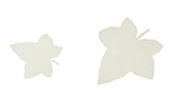|
Candle Magic ~ The Colour & The Flame
an article by Blackhawk
Candles,
in one form or another, have been used in magic,
ceremony & ritual for thousands of years - though
coloured candles and specific Candle Magic are a
relatively new phenomenon, due to the materials
required to create modern vivid colours being prohibitively
expensive or not discovered until relatively recently.
Two aspects of the candle come to the fore when
considering its magical, ritualistic or ceremonial
use - the colour [of the wax] and the flame.
The flame is more than symbol. Long before the dawn
of Man there was fire. For countless millennia fire
roamed the Earth unobstructed - and to a great extent
continues to this day. The containing [in part]
of such a powerful element by Man was magical in
itself, raising the human race almost to the level
of gods. Fire is life; fire is eternal; fire is
power; fire is the heat of creation itself, the
source of all existence. Fire is cleansing; fire
is purging; fire is a focus of meditation and an
element which demands the greatest respect.
The colour of the candle itself [or rather the colour
of the dye used to add colour to the wax, which
for many ritualistic purposes is usually required
to be solid and of equal hue through the body of
the candle] also has a bearing on its use, although
the choice of colour is perhaps mostly subjective
[no offence or slight meant towards colour therapists,
etc. Any response to this assertion is welcomed.],
and the use of certain colours can be controversial
or misunderstood. Black candles, for example, are
seen by many people [due to historical and contemporary
cultural misunderstandings] as being used to promote
evil, contrary to their ‘actual’ use in
banishing or dispelling ‘evil’ or negativity.
So from red [the colour of passion, desire and emotion],
to green [the colour of growth and prosperity];
from white for spiritual cleansing and peace to
black for dispelling negative energies - colours
are identified with aspects of life which we may
choose to enhance or seek protection against. In
all this the relationship of colour to aspect is
personal and open to interpretation.
As with all ritual, the purpose of candle magic
is to focus the mind of the practitioner[s]. To
this end, though various tables of reference exist
as guides, personal preference and intuition should
be taken into account when considering candle colours.
What does this shade of green say to you? Does the
colour red feel right for this kind of ceremony
/ ritual / spell? What colour in your opinion suggests
hope and determination?
Candles can often be crucial background to a ritual,
setting the scene, creating a mood for a ceremony
involving other aspects or tools, but with Candle
Magic the candle takes centre stage. Red candles,
green candles; fat or thin; hand-dipped, solid-colour
and perfumed with essential oils or plain, shop-bought
wax tubes, the candle is a focus for meditation,
contemplation or the gathering and directing of
energy. As with all rituals, this focusing of energy
must be treated with respect - more so than usual
when dealing with the most powerful and dangerous
of all elements - Fire!
An example of a Candle Magic ritual : Although there
is no ‘typical’ recipe for ritual, there
are some ingredients which are widely used. Some
of these ingredients may suit some practitioners,
others may not. It is up to the individual to decide
on their own recipe.
Cleansing & Preparing of Ritual Space.
This can often be as simple as “casting a circle”
- literally drawing a circle on the ground, in the
air or even in the mind, which serves as a protective
wall for the purpose of ritual - or a complex set
of actions which involve cleaning, sweeping, scrubbing
the area on which the ceremony will take place,
perfuming a room, burning incense to cleanse the
air, chanting or calling on relevant spirits, entities
or aspects to help cleanse and protect the space.
Cleansing & Preparing of Ritual Items.
Again, this can be as simple as doing a little dusting,
polishing bowls or an athame, to cleansing ‘mini-rituals’
as mentioned above, anointing candles with anointing
oils, the placing of items on a pentacle in order
to symbolically sanctify them, chanting, calling
on spiritual or other entities to cleanse and protect
etc. As above, this is all done to concentrate and
focus the mind, attitude and direction of the practitioner.
Main Body of Ritual / Spell.
The beauty of Pagan ritual is its infinite adaptability.
There is no one central figure which must be called
on for any particular reason; there is no one right
way to conduct a spell or a ceremony. All of this
is open to individual interpretation. Magic, ceremony,
ritual and worship itself is, and should be, a work
of art created by each person, suiting their requirements
and their personality.
The many variations of the Wiccan Rede - “if
it harm none, do what you will” - seem to be
the central tenet of the wide variety of Pagan belief
systems. So long as what you do harms none, including
yourself, do what you will. Do what feels right.
All that matters is intent, and truth to oneself.
Are we doing something good, helpful, positive,
constructive? Are we doing something of which Mother
Earth herself would approve? Each of us should ask
ourselves, because when it comes to intent, we are
the only ones who know if we’re telling the
truth!
There are literally tens of thousands of books,
and millions of websites which say “This is
the way”. The truth is : There is no way. There
is only intent, experience and consequence. If the
intent is positive [“if it harm none”]
and the experience is right for the individual [“do
what you will”] then the resulting consequences
should always be positive.
As far as Candle Magic is concerned, the main body
of the ritual will involve meditation and focus
on the coloured candle [the relevance of the colour
to the purpose of your ritual] and its flame, along
with visualisation or chanting to focus on any desired
outcome. Some practitioners like to write ‘wishes’
or objectives on a piece of paper, and burn it at
an appropriate part of the ritual. The involving
of deities and other figures is another aspect which
you may choose to include, though again, nothing
is written in stone. YOU are the practitioner. YOU
are the audience. YOU are your own teacher and your
own pupil. Find out what works for YOU.
So : pick your deities wisely, create spells using
the creativity and goodness within your own heart,
use tools and elements with respect, and ALWAYS
have a fire extinguisher or bucket of sand to hand
when conducting rituals using fire!
Winding Down.
Now that you have conducted your ritual or spell
to your own satisfaction, what do you do? Many people
suggest a winding-down aspect to each ritual, to
slowly dissipate the energies which may have been
built up during the exercise. Physically or psychologically,
this makes sense. Just as in meditation, exercise
or riding a playground roundabout, it can help to
slow down gradually rather than stop sharply.
At this stage we can bid goodbye to deities, aspects
or other entities. We can blow out or snuff out
candles, clear our circle, carefully replace our
ritual items, and restore ourselves to a point of
calmness and balance.. |
|












